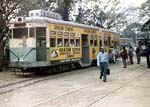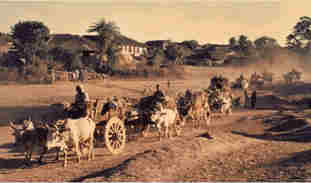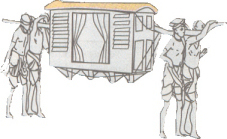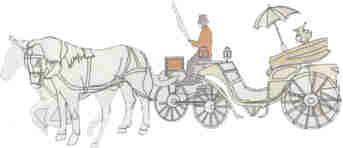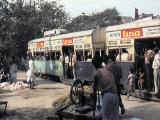|
|
kolkata trams |
|
||||
|
THE BIRTH:
This mode of transport was started about 2000
years ago. Rome ws under control of Augustus Ceaser . It was BC
27. The first tramcar of the
world was built by Franciscas, a Roman citizen. It
was a chariot for six persons to sit made of wood. This was pulled by one or two
horses on rails made of bronze.
Initially the tramcars plied in a route between Circus Maximus to
Porto Apea of Rome. Wihtin 20 years new routes were introduced in total
25 routes . The routes were named after alphabets. The nos. could not be
increased more than 25 as the total number of Roman alphabets were 25.
Later these were so
developed that some cars having 24 axles were pulled by 56 horses.
This tram system survived for approximately 500 years. Towards 476 AD due to
aggression by Tutonic, Hun and other clans the Roman empire was demolished.
With the surrender of Roman empire the Tram system was also dead. "Tramcars were also known as by different names in different parts of the world at different times. "Tram Cars" "Street Cars" Horse Cars" "trolley cars", "Light Rail Vehicles(LRV)".
There is a story how the name "TRAM" came . Some historians find the word 'tram' came from, after the name of a certain Mr. Outram, who developed , a new form of transport in England which later came to be powered by electricity and is famous in the form we see today. In the West, it is referred to as the CABLE CAR. and Light Railways. |
||||||
|
Austrian heritage railway,
reconstructed Horse-drawn tram |
Steam trams in Rockhampton, |
Petrol driven tram in Stockholm |
||||
|
KOLKATA Kolkata has many things to boast of . In fact, Metro rail and trams are two aspects of Kolkata, which still give the city an aura of exclusivity. Let us have a look at the chronology of transport in Kolkata: Calcutta is said to be born in 1690. ( There is huge difference of opinion in this matter) The citizens(?) of Calcutta at that time depended on Palkis ( Palanquins), Bullock carts or foot for going to places for about 100 years after 1690. It is known that rich people used to have private Palkis others had to hire. The roads were kutcha and there were traffic jam with bullock carts ! More than this some people were killed in Bullock Car accidents !! The rate of hiring palanquins was 3 annas per mile and one rupee 8 annas for the whole day. It is also learnt that the Palkiwallas resorted to strike in 1827 demanding increase of rates though it is not known Horse drawn Carriages were introduced towards the end of 18th. century. One European named Brownlow made a horse cart by cutting off the two carrying rods at the two ends of a Palki and fitted wheel underneath. this was known as Brownberry Cart. Gradually there various kinds of horse drawn carriages running on Calcutta streets. Some showpiece brands were named , Landow, Fetton, Tom Tom, Bruham etc. These were all used by Euoropeans and rich Indian Zamindars. The carts were beautifully decorated with costly fittings and pulled by big Arabian horses. Common people used box type carts with sick native horses. The idea of running tramcars in Kolkata actually was initiated in the year 1867 , the but the British rule permitted Government of Bengal in 1870 to run tramcars to carry merchandise from Sealdah Rly. Station. Accordingly Government of Bengal sanctioned Rs.1 lakh to start tramcars from Sealdah station to Armenian Ghat of Hooghly river , the main idea being to carry goods arriving from villages at Sealdah for transport to different parts of India through Railways The merchandise had to be unloaded at Armenian Ghat and then carried on boats or bullock carts to Howrah Station.. Evolution of Transport Systems In Kolkata 1900 : The Chinese
people brought a few Hand Rickshaws |
|
|||||
|
|
||||||
|
|
||||||
|
|
||||||
|
In
Kolkata tram cars were started on
18th.
February 1873. It was first a
car pulled by two horses brought from Australia. Wooden tram lines costing about
Rupees 150,000 were laid between Sealdah and Armenian Ghat by the side of
Hooghly river. Interstingly though meant mainly for carrying merchandise , the
first and subsequent runs were for carrying passengers. The first tram had three cars, one for First Class and
two for Second class for passengers
were coupled to form one unit. Each car was attached with two horses, thus 6
horses started the inaugural run of tramcars in India.
The
first run was funny. The horses refused to listen on looking at the peculiar
cars on wooden lines . There were hundreds of onlookers. Ultimately the
onlookers began shouting to
frighten the horses and the first tram car of Kolkata and India started rolling on.
Though meant for
passengers the cars were mostly used to carry goods. The Australian horses soon
became sick due to hot and humid weather of Kolkata. After 10 months of its
inaugural run towards end of 1873 the tram cars of Kolkata were stopped. |
||||||
|
Kolkata
was the Capital of British Indian Empire. Trade and commerce increased day by
day. Fast mode of transport was necessary.
Mr Parish Alfred of London and Mr. Chauter of Liverpool understood
the importance of the necessity for faster mode of transport to make trade
commercially more viable. With the
co-operation of Kolkata Municipal Corporation they incorporated the Kolkata
Tramways Company Limited (CTC) in 1880(Other opinion 1979) The same year on
10th. November again tramways were introduced in Kolkata with horse
drawn coaches, from Sealdah to
Dalhousie Square Central District.(according
to another opinion it was in January 1881). Gradually tramlines were laid to
Chowringhee, Esplanade, Chitpur Road, Shyambazar, Strand Road and Wellesley. New steel lines were laid from
Khidirpur to Esplanade(Dharamtolla). Old
Kolkatans still remember the journey from Kidderpore to Esplanade, through the
lush green Kidderpore Road and Race Course journey in a tram are bound to
experience some aspects of greenery of Kolkata. According to another source,
Tram services started in Kolkata more than a hundred years ago. First it was the
horse-drawn carriages which ran from Dharamtolla
to Barrackpur in 1880. It
took more than four hours to reach Barrackpur. But then, speed was not that
important those days. In fact no sign of any tram line is seen on the roads to
Barrackpur now. Another source says , Steam
drawn cars were also tried in Calcutta in May 1882,
but was abandoned being unsuccessful. The cars were all imported from England. The repairs were done in the workshop setup for the purpose in Kolkata. The coaches had Driver’s cab and behind the cab wooden seats were provided for passengers. The Driver had a “Foot Gong” to warn pedestrians. The “Foot Gong” is still being used. With the Industrial revolution in Europe there was trial for running tramcars with steam engines. This was also not successful. After invention of Electricity the first electric tram ran between Khidirpur and Esplanade on 27th. March 1902.
The old
design of wooden coaches was replaced with steel coaches with large windows.
Electrically operated trams have three types of brakes - electrical brakes, air
brakes and hand brakes. |
||||||
|
It is strange but true, that till 1952 all coaches were imported by the Kolkata Tram Company from England. The management of Kolkata trams was taken over by Government of West Bengal on 19th. July 1967 and was nationalised on 3rd. November 1976. Soon a bad patch followed for tramways. Large number of motor vehicles crowded the streets of Kolkata. It is a fact that Kolkata roads are less wide in comparison to those of other new cities of India and also covers less area . The population of the city has increased manifold. As a result, there are more cars on the road. But the amount of road space has not been increased proportionally. |
|
|||||
|
Non-existence of dedicated tram tracks gives rise to traffic bottlenecks, Buses, cars and trams has to jostle for space in the same area. In the event of breakdown of trams, it becomes a nightmare for drivers to navigate a road. Thus it was a common sight that long lines of immobile tramcars occupying roads, either due to traffic jam or power cut which plagued the people of Kolkata in mid 60's and 70's of the last century. It is also a fact that the new generation of travelling passengers would avoid the tramways and they prefer fast moving buses. High maintenance costs - each tram car costs five times more the cost of a luxury bus, the maintenance of tracks is a perennially high cost area. Every crossing has to be manned to change the tracks of the trams. All these problems have forced the government to think of phasing out trams. The envy of many developed countries, Kolkata's tramways network is a priceless asset which should be preserved. Many European countries who in the 1950s and 1960s had discarded trams for being slow, obsolete and a source of traffic congestion are now spending millions of dollars re-laying tracks and bringing back trams because they are eco-friendly, efficient and economical. The state government has signed an agreement with ICF Kaiser International Inc to conduct a feasibility study for modernisation of CTC. In fact, Mr. Jyoti Basu has asked the same American transportation firm to carry out a feasibility study in 1995, bearing in mind the indigenous problems of Kolkata. Nothing happened. Some months later a German company showed interest in revamping the tramways. This too fizzled out. It is heard that elevated separate tracks with new speedier tramcars are being planned to attract tourists. The need of the hour is less discussion and more action. Let there be no more doubts about the survival of Kolkata's trams. Instead of wasting money on more studies, it can be put to better use modernising the tramways. Let us see what the government does to preserve this oldest heritage of Kolkata. |
||||||
|
CHRONOLOGY 1873
:- The attempt to run a tramways service between Sealdah and Armenian Ghat
Street of route length 2.4 mile was made on
1880
:- The Calcutta Tramways co ltd was formed and registered in London on 22nd Dec
, Meter -gauge horse-drawn tram track 1882 :- Steam locomotives were deployed experimentally to haul tramcars. By the end of the nineteenth century the Company owned 186 tramcars, 1000 horses, 7 steam locomotives and 19 miles of tram tracks. 1900 :- Electrification of Tramways and simultaneous reconstruction of tracks to the standard gauge (4'-8˝ '') was taken up. By the end of 1905 the entire system was converted to an electric traction. 1905 :- Howrah station to Bandhaghat section for tramways was opened in June. Lines to Sibpur via G.T. Road was made ready in 1908. 1943 :- The Calcutta system was connected with Howrah section through the new Howrah bridge in Feb with this extension , the total track length reached 42.09 miles (67.73Kms). 1951 :-The Govt. of West Bengal entered into an agreement with the Calcutta Tramways Co and the Calcutta Tramways Act, 1951 was enacted . The Govt took over all rights with regard to Tramways and reserved the right to purchase the system on 1st Jan, 1972 or any time thereafter giving two years notice. 1967 :- The Govt of West Bengal passed the Calcutta Tramways Company (Taking Over of Management ) Act, 1967 and took over the management on 19th July 1967. On November 8th, 1976 the Calcutta Tramways (Acquisition of Undertaking) Ordinance , 1976 was promulgated under which the Company with all its assets vested with the government. 1970 :-The Howrah sections were closed down in Oct 1970 and Dec 1971/1973 Nimtala Ghat route was closed down in May 1973. The total track length was reduced to 38.58 miles (62.08kms).
1985
:-On April 17, extension of track was completed connecting Maniktala to
Ultadanga Station via Maniktala Main road (3.7 kms) 1986 :- On Dec 31 further extension of tram track from Behala to Joka was completed.
1992
:- Calcutta Tramways Company has taken a new venture by introducing Bus services
from 4th November 1992 initially with a |
||||||
Down the memory lane, when the tram made its maiden journey from Sealdah to Armenian ghat, It left everyone spell bounded. In course of time,the trams has gone through vast modernisations but still it has rolled down the tracks like the tickings of Bigben. Having witnessed our glorious past in the rails,this tireless heritage has itself unfurled another golden chapter in our historical book.No doubt Kolkatan tram can be designated as a priceless pride having served as a rail witness from the era of Governor generals, maharajas to our present Kolkata & without which the Kolkatan history would remain incomplete. Kolkata Tramways' wheels that writes & sights our glorious past, present & our future too' |
||||||
| Source : Different News papers, articles and old magazines on History of Kolkata. & The CTC web site.and other web pages on Tramways in the web. | ||||||
|
A Tramway fan from Australia at Kolkata |
||||||


